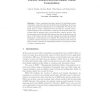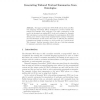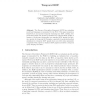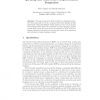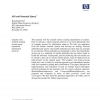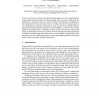ESWS
2005
Springer
14 years 5 months ago
2005
Springer
Online community sites have replaced the traditional means of keeping a community informed via libraries and publishing. At present, online communities are islands that are not int...
ESWS
2005
Springer
14 years 5 months ago
2005
Springer
Abstract. This paper presents the ONTOSUM system which uses Natural Language Generation (NLG) techniques to produce textual summaries from Semantic Web ontologies. The main contrib...
ESWS
2005
Springer
14 years 5 months ago
2005
Springer
Annotations of multimedia documents typically have been pursued in two different directions. Either previous approaches have focused on low level descriptors, such as dominant colo...
ESWS
2005
Springer
14 years 5 months ago
2005
Springer
The Resource Description Framework (RDF) is a metadata model and language recommended by the W3C. This paper presents a framework to incorporate temporal reasoning into RDF, yieldi...
ESWS
2005
Springer
14 years 5 months ago
2005
Springer
Business models on the basis of digital content require sophisticated descriptions of that content, as well as service-oriented carrier architectures that allow to negotiate and en...
ESWS
2005
Springer
14 years 5 months ago
2005
Springer
Semantic Web Services offer the possibility of highly flexible web service architectures, where new services can be quickly discovered, orchestrated and composed into workflows....
ESWS
2005
Springer
14 years 5 months ago
2005
Springer
As semantic markup becomes ubiquitous, it will become important to be able to ask queries and obtain answers, using natural language (NL) expressions, rather than the keyword-based...
ESWS
2005
Springer
14 years 5 months ago
2005
Springer
Abstract. This paper studies the RDF model from a database perspective. From this point of view it is compared with other database models, particularly with graph database models, ...
ESWS
2005
Springer
14 years 5 months ago
2005
Springer
ESWS
2005
Springer
14 years 5 months ago
2005
Springer
In the current research environment, funding agencies are increasingly required to demonstrate that the projects they fund represent value for money. When funds are disbursed in a ...
